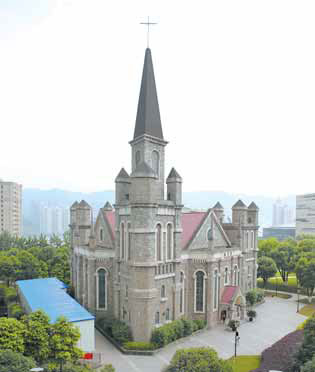City harbors global ambitions
Kang Bing and James Healy
Updated:2014-06-24
China Daily

Editor's note: Chongqing lies at the convergence of the Yangtze and Jialing rivers and its position has allowed it to act as a crossroads for inland trade. But the municipality's ambitions extend beyond its borders. China Daily recently explored the municipality and its focus on becoming a major international trade hub.
The municipality is pinning its future on becoming China's foremost inland crossroads for domestic and international trade, whether by air, water, rail or road. Kang Bing and James Healy report.
Chongqing, a growth-spurt city in China's awakening southwest, has been compared to Chicago because, like that midwestern American city in the 19th century, it stands as a gateway to development of the nation's western frontier. But Chongqing, one of four municipalities under the central government's direct control - and a pilot city that is pioneering China's inland development - could just as easily be compared to Texas, the US state that prides itself on doing everything on a grand scale. From cavernous new convention center facilities to sprawling factories to bustling mega-ports on the upper reaches of the Yangtze River, Chongqing has taken to heart the Texas big-is-best spirit in its recent urban growth. This is evident throughout the city, but especially in Liangjiang New Area, where construction cranes perched atop new high-rises are as common a sight as the lush foliage and countless trees that line the city's highways and boulevards.
Driving this growth, as the mountain-hemmed city of 30 million people overtakes the farmland and villages of its rich past, is a vision of Chongqing stepping onto the world stage.
"We want to become an international city," said Du Shulin, deputy director of Liangjiang New Area's information office.
Noting that coastal cities such as Shanghai have long enjoyed the fruits of robust investment and bustling exports, Du said, "We think it's our turn now."
'Everything is big'
It's evident that a bigger-is-better spirit is guiding the growth of Liangjiang New Area, the third national-development and opening-up zone in China (after Shanghai's Pudong New Area and Tianjin's Binhai New Area) and the first such area in inland China.
"Big projects and big planning - everything is big," Zhang Li, an associate research fellow with the Liangjiang New Area, said when describing the city's approach to becoming China's next major trade hub.
Take, for instance, the city's newest port on the Yangtze River, Guoyuan Inland Port. (Chongqing has eight ports along three rivers.) Built atop what used to be a riverside village, Guoyuan, inland China's largest port at 2,800 meters long, features 16 piers - 10 for loading and unloading cargo containers, three for automobile shipments and three for non-container goods.
The port's steady water levels through all four seasons will make Guoyuan available year-round to even the largest cargo ships, said Liu Jian, general manager of Guoyuan Port Container Corp.
Guoyuan is a sleeping giant, however. Its rail link won't be finished until October, with its opening set for next year's Spring Festival, Liu said. And the port, which opened in December, is still in low gear.
"Because this port is new, shipping companies need time to plan and know the port. They are still making arrangements," Liu said. Even so, the port expects to handle 100,000 cargo containers this year, 350,000 next year and 800,000 in just five years, he said.
In the meantime, Cuntan Inland Port is the workhorse among Chong-qing's ports.
"While Shanghai is an important port at the end of the Yangtze River, Cuntan is an important port at the start of the river," said Qu Hong, general manager of port operator Chongqing International Container Terminal Co Ltd. "Of all the goods transported from Chongqing to overseas, 90 percent of them are transported from here."
Cuntan, which is 1,316 meters long, features nine piers, seven of which can load cargo simultaneously, and two of which are specially designed for loading automobiles onto ships. On one recent day, a five-deck cargo ship with 1,300 cars made in Chongqing was anchored offshore, awaiting the journey to Shanghai.
In 2006, when the port opened, 46,000 cargo containers, import and export combined, came through Cuntan, Qu said. Last year, the port handled 650,000 containers and expects to handle 700,000 this year.
Because Chongqing's industry is developing so rapidly, port officials foresee 1 million containers a year going through Cuntan in three to five years, Qu said. The port's maximum capacity is 1.4 million cargo containers a year, he added.
One advantage of Cuntan port, Qu said, is the meat and fruit distribution center being built on a hillside beside the port. It's a coup for Cuntan, considering the stricter regulations on the shipment of such products by water versus air. Guoyuan's Liu said his port will have no such facility.
However, when Guoyuan is completed, it will be the only inland port to boast water, road, rail and air links - linchpins for Chongqing's ambition to become inland China's most accessible inland trade hub.
Silk Road connection
With an eye to boosting import traffic and domestic demand along with facilitating the exports from Chong-qing's growing industrial might, the river city is taking full advantage of its land connections as well, particularly the Chongqing-Xinjiang-Europe railway, which is part of the new Silk Road.
"Its original purpose was for an export channel," Ling Yueming, director general of the Administrative Committee of Liangjiang New Area, said of the 11,179-km railway that links Chongqing and Duisburg, Germany, by way of Kazakhstan, Russia, Belarus and Poland (and which makes trade stops in all those countries).
"But we're also strengthening efforts to bring back cargoes from European countries," Ling, a member of the Standing Committee of the CPC Chongqing Municipal Committee, said in an exclusive interview with China Daily. "By organizing return cargo, we reduce the trade deficit between China and Europe and reduce logistical costs."
Besides, he said, "reliance solely on exports is not sustainable. Our economic development cannot go without the rest of China and the world. And the development of China relies on three 'horse carriages': domestic demand, exports and investment."
While coastal cities rely on exports to drive economic development, he said, Chongqing is looking to ride all three carriages to sustainable growth. In addition to stoking domestic demand for the fruits of Chongqing's industry, including laptop computers, automobiles, helicopters and small airplanes, the city aims to attract investment by streamlining the registration process for new enterprises.
"All enterprises can go through the registration process with just one application table now, one window, and finish in one day," Ling said. "This simplification of business registration procedures will change pre-approval into post-registration. For business registration, we will no longer ask a bank for a deposit letter. (An enterprise) will just have to promise they will get capital ready in three to six months. This is an efficient way to cut costs."
Ling said such reforms will help accelerate local development.
Showcasing the city
Chongqing also is taking steps to feed traffic into the burgeoning trade hub.
Liangjiang New Area recently launched an English-language website to spotlight success stories and to attract investment and foreign trade, especially from Europe. And to showcase what is available for import, the city built the Commodity Trading Exhibition Center, a sprawling venue where wholesalers (and eventually retail shoppers) can visit numerous shops to preview available goods, from American-made automobiles to French wines.

Additionally, to draw tourist and business trade to the New Area, the city has constructed the super-sized Yuelai Exhibition & Convention City, which General Manager Shi Jian said is the biggest in western China. The center, just 15 minutes from the airport, features an adjacent five-star hotel (still under construction), 18 restaurants, exhibition areas, a grand ballroom and a 20,000-square-meter multifunctional hall that can hold from 15,000 to 20,000 people. The hall "is one of only four such pillar-less halls in China", Shi said.
Surrounding the center will be residential buildings and plenty of green space, and Shi envisions the center and adjoining areas eventually becoming a "sustainable smart city" with its own parks and schools, a projected population of 80,000 and a total area of 12 million square meters.
Meanwhile, although Chongqing looks firmly ahead to a booming future, its planners also are mindful of the city's past.
Chongqing is taking steps to preserve its heritage in such places as Long Xing (Prosperous Dragon) Ancient Town, where winding stone streets lead past ancient temples and teeming alleys, and where some families still draw their water from ancient wells.
The city also is resurrecting its past by building a replica of Old Chong-qing in the New Area. The true-to-size buildings, faithfully reconstructed with old stone and brick, will eventually cover 350,000 square meters in the Liangjiang International Film City, where part of the 2012 movie Back to 1942 was filmed. Visitors can stroll along streets that duplicate 1940s-era Chongqing, including shops, restaurants, a theater and a Flying Tigers Club, climb stone stairways that follow the steep hillsides, and commune with songbirds and butterflies while gazing at rows of mist-covered mountains.
Contact the writers at kangbing@chinadaily.com.cn and jameshealy@chinadaily.com.cn
|
Cuntan Inland Port in Chongqing has two of its nine piers for loading automobiles onto ships. Located in Liangjiang New Area, the port is expected to handle 1 million containers a year in three to five years, up from 650,000 containers in 2013. Yuan Zhiqiang / for China Daily |
|
A church stands in Liangjiang New Area, which is the third national development and opening-up zone and the first in inland China. Wang Jing / China Daily |
|
A newlywed couple pose for photos in Liangjiang New Area in May. The development area is designed to include not only the biggest convention center in western China, but also residential buildings and plenty of green space. Wang Jing / China Daily |


(China Daily 06/24/2014 page6)
Video

John Edwards, the UK trade commissioner for China, praised Chongqing over its rise as a burgeoning center in intelligent manufacturing.








